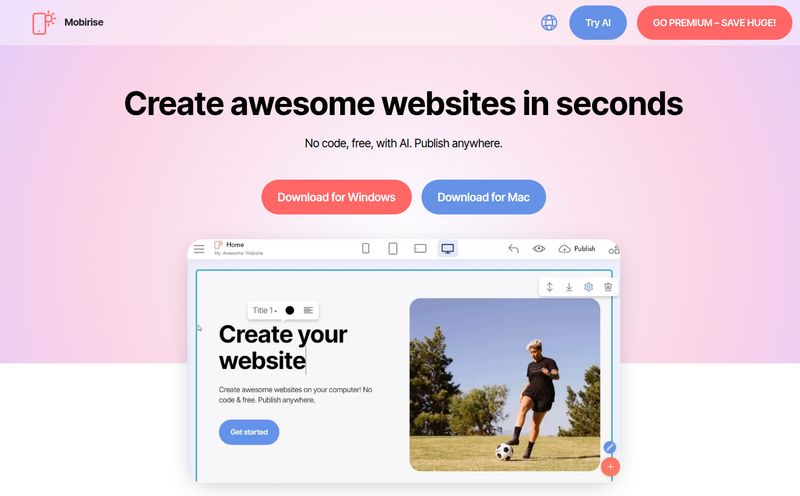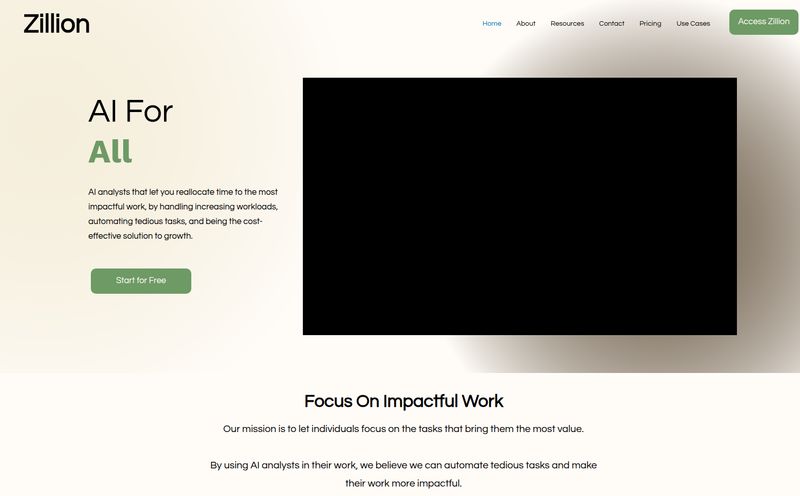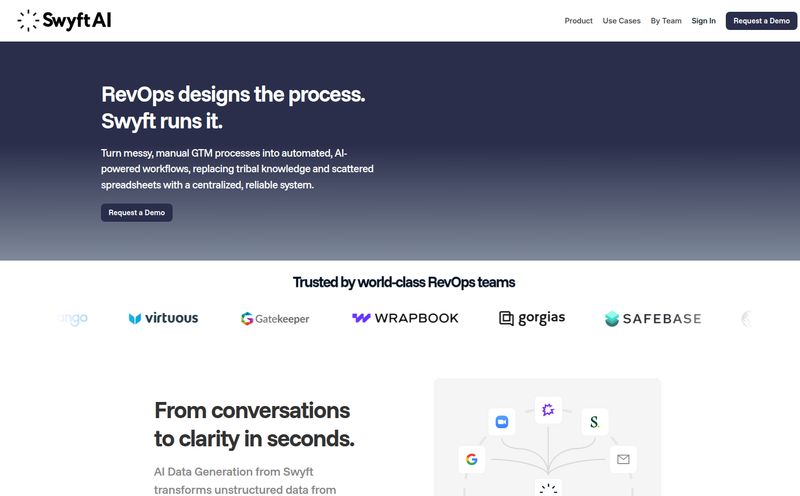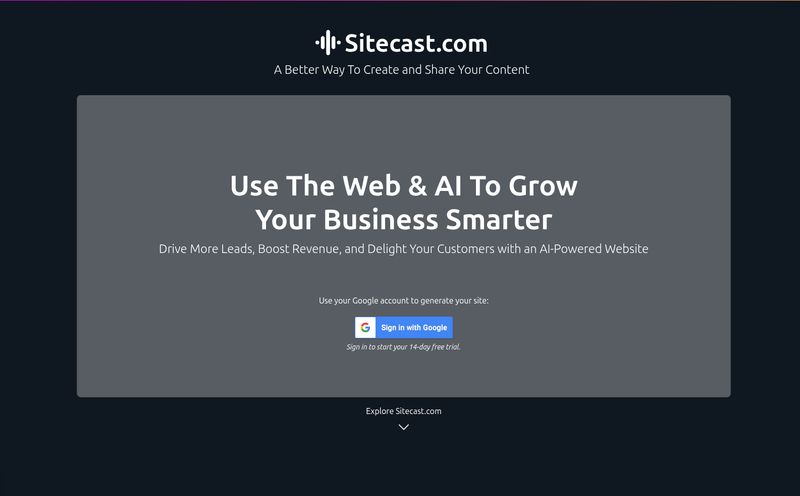Let me tell you a story. It’s a story I’m sure you’ve lived if you’ve ever tried to spin up a side project. You’ve got a killer idea, the frontend is mocked up, you're buzzing with excitement. And then it hits you. The backend. You need a database, an API, authentication, maybe some scheduled tasks. Suddenly your weekend project has turned into a week-long unpaid DevOps internship. It’s the enthusiasm killer. The project graveyard is filled with brilliant ideas that died on the hill of backend configuration.
For years, the industry has screamed “No-Code!” or “Low-Code!” as the solution. And, I’ll be honest, my eyes usually glaze over. Most of these platforms feel like they’re built for people who’ve never seen a line of code, and they treat you that way. You inevitably hit a wall, a limitation so fundamental you have to abandon the platform and start over. They’re like beautifully decorated prisons. You can do anything you want, as long as it’s what the warden allows.
Then I stumbled across Koxy AI. And the first thing I saw on their site was a demo where someone typed “I hate no-code tools. Create a good one” into an AI prompt. Okay, you have my attention. That’s the kind of self-aware, developer-focused attitude that makes me think maybe, just maybe, this one is different.
So, What Exactly is Koxy AI?
At its core, Koxy AI is an AI-powered serverless low-code platform. That’s a lot of buzzwords, I know. Let's break it down into something that doesn't sound like it was written by a marketing bot. Think of it as a toolkit that builds and manages your entire backend for you, but lets you grab the wheel whenever you want. It combines a visual, drag-and-drop interface for building application logic with the power to generate parts of that logic using simple text commands. And it’s all “serverless,” which is a fancy way of saying you don't have to worry about managing servers, scaling, or any of that infrastructure headache. It just works.
The magic here is that it doesn't seem to be aimed at replacing developers. It’s aimed at making them faster and more focused on what actually matters—the unique logic of their application, not the boilerplate plumbing that comes with it.
The Features That Actually Matter
A platform is only as good as its features, right? Here’s what stood out to me from poking around Koxy AI.
The AI Node Generation is a Bit of Magic
This is the headline act. Koxy has an AI that can build workflow “nodes” (think of them as individual functions or steps in your process) from plain English or even voice commands. Instead of manually finding the right API connector, configuring it, and adding the logic, you can just… ask for it. “Create a node that fetches user data from the database and sends a welcome email.” It’s like having GitHub Copilot, but for your whole application architecture.
This could be a monumental time-saver, especially for common patterns that we all rebuild a thousand times. It's not about the AI writing your entire app, it's about it being a brilliant assistant that handles the grunt work.
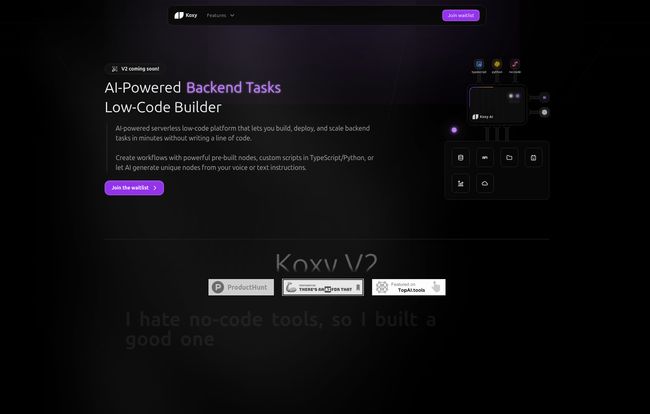
Visit Koxy AI
A Visual Builder That Doesn't Feel Like a Toy
The core of the experience is a visual workflow builder. You drag lines between nodes to create logic flows. We’ve seen this before, but Koxy adds a detail that developers will appreciate: Type-Safety. This means the builder understands the type of data flowing between your nodes (e.g., text, number, user object) and can help prevent errors before they even happen. It’s a small thing that signals a much deeper, more robust foundation. It’s less like drawing a flowchart in PowerPoint and more like assembling a pre-validated circuit board.
Finally, Auto-Generated Docs That Aren't Awful
I despise writing documentation. There, I said it. It’s tedious, it’s always out of date, and nobody reads it until something is on fire. Koxy’s promise of “Auto Docs” is music to my ears. The platform automatically generates documentation for all your APIs, nodes, and workflows as you build them. If this works as advertised, it solves one of the biggest sources of friction in team-based development. New team members can get up to speed faster, and you always have a source of truth for how your backend actually works.
Breaking Out of the No-Code Jail with Custom Code
For me, this is the most important feature. This is the escape hatch. Koxy AI allows you to write your own custom nodes in TypeScript or Python. This completely changes the game. The moment you hit a limitation of the visual builder or need a super-specific library or algorithm, you aren’t stuck. You can just drop into code, write what you need, and plug it right back into your visual workflow. This hybrid approach is what separates a professional tool from a hobbyist toy. It gives you the speed of low-code for 90% of your work, and the power of real code for the other 10%.
The Good, The Bad, and The Serverless
No tool is perfect. Let's talk about the real-world tradeoffs. The biggest advantage is obviously speed. The ability to go from an idea to a fully functional, scalable backend in minutes or hours instead of days or weeks is incredible. The serverless architecture means you don't have to think about scale—if your app suddenly gets a million users, it should (in theory) just handle it. That's a huge weight off a founder's or solo dev's shoulders.
But there are things to consider. The most obvious is platform lock-in. When you build on a platform like Koxy, you're building in their ecosystem. Migrating away from it would be a major undertaking. This is the classic trade-off with any Backend-as-a-Service (BaaS) platform, from Firebase to Supabase. You're trading control for convenience.
There's also the learning curve. While it looks simple, I'm sure getting into advanced features and understanding the nuances of how the platform operates will take time. And the elephant in the room: V2 is coming soon. This is exciting, it means the platform is actively being improved. But it can also mean a period of flux. Features might change, things might break. It’s the price of admission for being on the cutting edge.
What's the Damage? Koxy AI Pricing
This is the big question, and right now, there's no public answer. The Koxy AI website doesn't have a pricing page up yet, which is pretty common for a product that's still in a heavy development phase with a V2 on the horizon. My guess? We’ll probably see a model similar to other players in the space: a generous free tier for small projects and hobbyists, with paid plans based on usage (like CPU time, database reads/writes) and possibly per-user seats for team features. For now, we'll have to wait and see.
Who is Koxy AI Actually For?
After looking it all over, I think Koxy AI has a few sweet spots:
- Startups and MVP Builders: If you need to validate an idea quickly without sinking a ton of cash and time into backend engineering, this seems like a perfect fit.
- Indie Hackers & Solopreneurs: A single person can wield a massive amount of power with a tool like this, building and launching products that would have required a small team just a few years ago.
- Frontend Developers: If you're a React or Vue wizard who wants to build full-stack applications but the thought of setting up a Node.js server with Express and connecting it to a Postgres database makes you tired, this is your bridge to the backend.
- Internal Tools Teams: Companies that need to quickly build custom automations and internal applications could get a lot of mileage out of this.
My Final Take: Is Koxy AI Worth the Hype?
I'm cautiously optimistic. I’ve been burned before, but Koxy AI seems to be hitting all the right notes. It acknowledges the failures of its predecessors by embracing developers, not trying to abstract them away. The combination of AI-powered generation, a robust visual builder, and that all-important custom code escape hatch is a powerful recipe.
It feels less like a strict no-code platform and more like a next-generation cloud IDE. It's a tool I will genuinely be keeping a close eye on. When V2 drops, I’ll be first in line to give it a proper test drive. It might just be the thing that finally gets some of my own graveyard projects back on their feet.
Frequently Asked Questions about Koxy AI
Is Koxy AI a no-code or low-code platform?
It's best described as a low-code platform. While you can perform many tasks without writing code, its true power comes from its hybrid approach, which allows you to inject custom TypeScript or Python code when needed. It provides a "no-code" on-ramp with a "pro-code" ceiling.
What languages can I use for custom code in Koxy?
Currently, Koxy AI supports TypeScript and Python for writing custom nodes and logic, covering two of the most popular languages for backend and data science work.
Is Koxy AI suitable for large-scale production apps?
It's built on a scalable serverless infrastructure, which is designed for production workloads. So, technically, yes. However, as with any managed platform, you should consider the implications of vendor lock-in and ensure its capabilities match your long-term roadmap.
Can I host Koxy AI on my own servers?
No, Koxy AI is a fully managed cloud platform. The value proposition is that they handle all the infrastructure, deployment, and scaling for you, so you don't have to.
How does the AI node generation work?
You provide a natural language prompt, either through text or voice, describing the function you want to perform. The AI then interprets this request and generates a pre-configured workflow node that you can drop into your application logic.
When will Koxy AI V2 be released and what is the pricing?
The company has announced that V2 is "coming soon," but an exact release date has not been made public. Similarly, pricing information is not yet available but is expected to be released closer to or with the launch of V2.
Reference and Sources
For the most current information and to sign up for updates, visit the official website:
